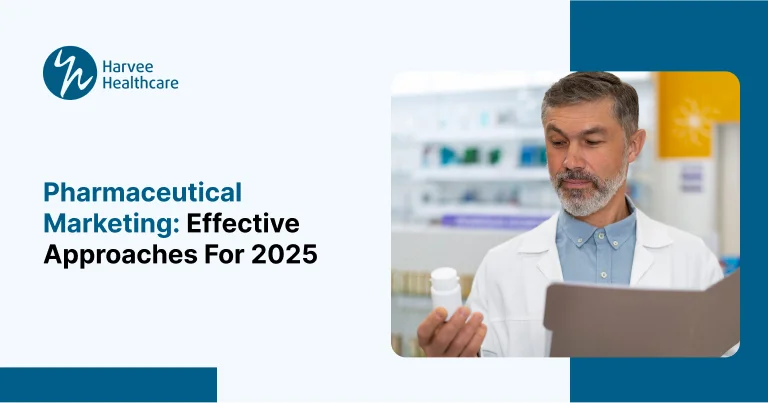
Pharmaceutical Marketing: Effective Approaches for 2025
Every sector needs a detailed marketing plan; likewise, the pharma sector also needs a marketing strategy to achieve its objective. The marketing practices landscape is shifting rapidly from ethical practices to modern digital strategies too in the pharma industry adapting to the latest techniques is undeniable.
Pharmaceutical marketing continues to evolve in 2025 with new technologies, stricter regulations, and heightened consumer expectations. Continue reading this blog post to learn about what pharmaceutical marketing is, the best practices and effective channels.
Pharma marketing has very strict regulations in almost all countries, and in particular, this blog post explains India’s regulatory framework under the Uniform Code of Pharmaceutical Marketing Practices (UCPMP).
What is Pharmaceutical Marketing?
Pharmaceutical marketing refers to the strategies and activities used by pharmaceutical companies to promote their products, like prescription medications, over-the-counter drugs, or medical equipment, to healthcare professionals (HCPs), patients, and institutions.
It is more complex than traditional marketing because it must balance commercial goals with regulatory compliance and ethical responsibility. The goal is to increase awareness, educate stakeholders, and improve health outcomes while adhering to medical standards and legal frameworks.
Example: A company launching a new diabetes drug might market it to doctors through clinical studies, digital campaigns, and continued medical education (CME) programs while educating patients through social media or wellness apps.
Pharmaceutical Marketing Practices in 2025
Pharmaceutical marketing strategies in 2025 have evolved to prioritize personalization, ethics, and engagement. Because pharma marketing strategies are driven by digital innovation and a stronger focus on patient needs. The best practices include,
- Evidence-Based Promotion
- Personalization and Segmentation
- Digital Medical Education
- Ethical Marketing
- Omnichannel Engagement
1. Evidence-Based Promotion
Don’t just showcase product benefits like old strategies because companies now use real-world evidence (RWE), like clinical trial data and patient case studies, to support claims.
Real-world evidence builds trust among physicians and regulators. Also, you can refer to the real-world evidence framework built by the FDA in 2018.
2. Personalization and Segmentation
Marketers use data analytics to segment healthcare providers based on speciality, location, and prescription behaviour. This helps in personalized, tailored messaging, which can enhance relevance and improve conversion.
3. Digital Medical Education
Online CME (Continuing Medical Education) platforms and webinars have become essential tools for pharma reps to engage healthcare professionals in a time-efficient and compliant manner.
4. Ethical Marketing
There’s a clear shift toward transparency. Freebies and gifts to doctors are increasingly discouraged or banned in many countries and that includes India too. Marketing materials must disclose risks, not just benefits.
5. Omnichannel Engagement
Pharma companies now employ a mix of face-to-face detailing, video calls, email campaigns, medical portals, and social media to engage doctors and patients through their preferred touchpoints.
Follow a multichannel marketing strategy in 2025 to attain your pharma business objective. The below image shows the Pie chart demonstrating components of marketing budget for the first six months of practice activity.

Below, we have explained multiple pharmaceutical marketing channels.
Pharmaceutical Marketing Channels
Modern pharma marketing integrates both traditional and digital channels. Here are some of the most effective ones,
- Physician Detailing
- Medical Conferences & Webinars
- Digital Marketing
- Patient Education Campaigns
- Email & CRM Systems
- Public Relations and Thought Leadership
1. Physician Detailing
Physician detailing remains at the core of pharma marketing. Where a pharma company appoints medical reps to visit the doctors to discuss product benefits with the help of clinical data. In 2025, remote detailing via video calls is common because it saves time and increases reach.
2. Medical Conferences & Webinars
These are prime platforms to showcase new drugs and connect with key opinion leaders (KOLs). Virtual attendance options have grown post-COVID-19.
3. Digital Marketing
Search engine optimization (SEO), paid ads, mobile apps, influencer collaborations, and social media campaigns are all part of a company’s strategy to reach digitally active patients and practitioners.
4. Patient Education Campaigns
The educational content on disease awareness, proper medication use, and lifestyle changes build brand trust. For instance, a company making heart medications may run online campaigns promoting heart health.
This guide explains some of the best medical public awareness campaigns and their benefits.
5. Email & CRM Systems
Automated email campaigns via customer relationship management (CRM) tools help nurture relationships with doctors, pharmacists, and healthcare institutions.
6. Public Relations and Thought Leadership
Publishing whitepapers, articles, and research collaborations enhances credibility and positions the brand as a thought leader.
Uniform Code of Pharmaceutical Marketing Practices (UCPMP) – India’s Regulation
In India, pharmaceutical marketing is governed by the Uniform Code for Pharmaceutical Marketing Practices (UCPMP). This code was updated in 2024, which mandates ethical standards for pharma companies and their representatives.
Access the full UCPMP 2024 document here: Uniform Code of Pharmaceutical Marketing Practices – 2024
Key Provisions of UCPMP 2024
- No Gifts or Incentives: Pharma companies are prohibited from offering gifts, cash, travel facilities, or hospitality to doctors or medical practitioners.
- Transparency in Sponsorship: All sponsorships for CME events or conferences must be clearly disclosed. Doctors must not receive personal benefits from such sponsorships.
- Promotional Material Regulations: All product promotional materials must include valid, up-to-date information and comply with advertising standards.
- Training for Reps: Medical reps must be adequately trained and must not make exaggerated or unverified claims.
- Monitoring Mechanism: Companies are required to submit self-declarations of compliance, and violations may result in penalties or blocklisting.
This move marks a step toward cleaning up the perception of the pharma sector and aligning Indian practices with international norms.
The Shift Towards Digital and AI in 2025
AI-driven tools are transforming how pharma marketing works as they offer pharma marketers,
- Predictive Analytics: Forecasting prescribing patterns and customizing outreach.
- Chatbots for Doctors: Providing instant product information or samples.
- Virtual Reality (VR): Training healthcare professionals using immersive simulations.
- AI Content Creation: Generating automated, compliant marketing content for different physician segments.
Examples of Effective Pharma Marketing Strategies
Case 1: Pfizer’s Digital Outreach
Pfizer’s campaigns in India included targeted webinars and partnerships with doctor networks like Practo to spread vaccine awareness—blending educational content with brand communication.
Case 2: Sun Pharma’s Patient Awareness Campaigns
Sun Pharma has launched several disease awareness initiatives, particularly in dermatology, using influencer videos and telehealth integration to reach rural and urban audiences alike. Here’s an example of a Sun Pharma campaign on raising awareness of Acne and its Impact on Everyday Life.
Pharmaceutical Marketing Challenges in 2025
Despite the progress, pharma marketers still face some hurdles. That includes,
- Regulatory Complexity: Navigating local and global compliance remains tough.
- Doctor Access Restrictions: Hospitals limit in-person visits. So, most pharma companies are pushed to innovate digitally.
- Patient Privacy Laws: Stricter data protection norms (like India’s Digital Personal Data Protection Act) make targeted campaigns more complex.
Best Practices for Pharma Marketing in 2025
- Build Trust, Not Just Sales – Use transparent messaging backed by data.
- Stay Compliant – Follow local laws like UCPMP and international standards.
- Leverage Technology – Use CRM, AI, and automation tools for efficiency.
- Engage Patients Proactively – Empower them with information and tools, not just products.
- Train Teams Regularly – Ensure reps and marketers understand both product science and legal obligations.
Takeaway
Pharmaceutical marketing in 2025 demands a blend of innovation, ethical integrity, and digital agility. The Pharma industry is moving toward more responsible and value-driven marketing with increasing regulations like the UCPMP 2024 in India and also the global rise in patient empowerment. If you are a pharma company, then you need to invest in data, technology, compliance, and human connection to be very successful.
Investing in digital marketing is very important in 2025. If you are looking to boost your pharmaceuticals online presence, then contact Harvee Healthcare.
Search
Recent Post
Categories
- AI in Healthcare
- Content Marketing
- Dental
- dental Digital Marketing
- Google Ads
- Google my business
- Healthcare marketing
- Healthcare SEO
- Internet Marketing Tips
- Lead Generation
- Local SEO
- Patient Satisfaction
- pay per click
- Pharma Marketing
- Social
- Social Media Marketing
- Traffic
- Website
- Website Designing
Contact
Get in Touch With Us
Coimbatore Address
- 21/1, Periasubbanna Gounder Street, K.K.Pudur, Coimbatore, Tamil Nadu 641038.
- 098942 76263
- info@harveehealthcare.com

Chennai Address
- RMZ Millenia Business Park, Level 6, Phase II, Campus 4B Unit 602A, Kandancavadi, Perungudi, Chennai, Tamil Nadu 600096.
- 098942 76263
- info@harveehealthcare.com

Dubai Address
- Umm Sequeim 3, Jumeirah Rd Opposite Burj Al Arab, Villa #1 855 A Dubai.
- info@harveehealthcare.com

United Kingdom Address
- 3/2 Powderhall Rigg Edinburgh, United Kingdom EH7 4GA.
- info@harveehealthcare.com

Copyrights © 2025 harvee.co.uk










